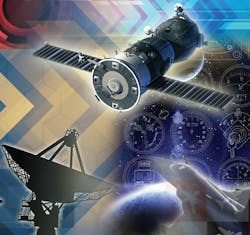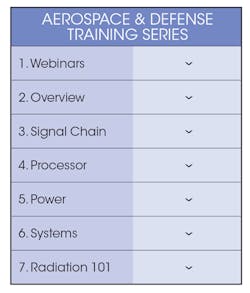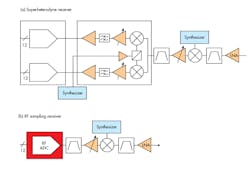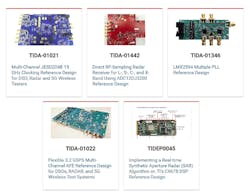Online Resources Help Designers Meet Aerospace/Defense Requirements
Download this article in PDF format.
There’s no doubt that as electrical engineers, we’re in a complex and fast-moving profession. Each market segment—automotive, consumer, aerospace, industrial, etc.—has its own set of unique product requirements and applicable standards (Fig. 1). At the same time, there’s a push across all segments to do more with less: higher performance, smaller packages, and lower power consumption, for example.
1. Aerospace and defense applications must maintain a high level of performance under extreme conditions. (Source: “TI Components for Space, Avionics and Defense” PDF)
It’s tough to keep up with the latest developments in a particular field. Some estimates place the half-life of an engineering degree at between 2.5 and 5 years, and the time needed to stay current at up to 20 hours per week. The result? Working engineers must continuously brush up on their knowledge if they’re to remain state-of-the-art.
Sponsored Resources:
- Maximize your Data Converter Performance, while Minimizing Performance Degradation
- Aerospace & Defense Training Series Now Available
- Commercial Aircraft Radar Solutions
Engineering Resources from Texas Instruments
Not that we want to blow our own trumpet (well, okay…), but Texas Instruments (TI) is at the forefront of industry efforts to help working engineers upgrade and update their skills. That commitment stretches back decades to legendary collections of application notes from companies such as Burr-Brown, Unitrode, and National Semiconductor. All three are now part of TI, and much of that material is still available online.
On the TI website, you’ll find a huge selection of technical resources. There’s product information, of course, but also:
- Design tools and software such as those in the WEBENCH Design Center
- Reference designs that go beyond the datasheet to show how to solve common design problems, how to use a device in a subsystem, or how a device performs in a specific application
- Online video training and tutorials
- The E2E support forums and blogs
- Design seminars
- Technical articles, white papers, and application notes
- Products and services from the TI Design Network
The material covers all of Texas Instruments’ product lines, so you’re encouraged to visit and explore.
Space, Avionics, and Defense Resources for Engineers
As an example of the available resources, let’s take a closer look at the Space, Avionics, and Defense market. This industry includes aircraft systems for engine control and flight control; ruggedized communications for defense and avionics; smart munitions; and a broad range of space-bound applications.
Products in this segment must operate over years, if not decades, in an extremely harsh environment. In addition, space products must survive exposure to high levels of radiation, so they must meet specialized testing and qualification requirements.
TI Space Products comprise the largest selection of radiation-hardened and assured products for space flight. TI has a proven legacy of over 45 years in the space market, offering a full signal-chain solution for both domestic and international programs.
The product portfolio includes rad-hard point-of-load (POL) power solutions, high-speed serializer-deserializer (SerDes) devices, and some of the world’s highest-performance data converters. The portfolio features components that comply with MIL-PRF-38535 QML Class V and Radiation Hardness Assured (RHA) standards. These devices are typically supported with total ionizing dose (TID) and single event effects (SEE) test reports that detail potential degradation in a space environment.
For earthbound aerospace and defense applications, TI’s Enhanced Products (EP) portfolio includes more than 750 commercial off-the-shelf (COTS) products that meet avionics, defense, and industrial standards for operating in environments where high quality and long service life are a requirement. Though these are products designed for harsh environments, more than 90% fall under the U.S. Department of Commerce EAR99 classification and can be sold worldwide with no restrictions.
The TI website has multiple resources to help educate yourself about the products and their application.
If your product is heading toward blast off, check out the Final Frontier section of the site. You might start by reading the Analog Wire blog entitled, “7 things to know about spacecraft subsystems before your next trip to Mars.” Do you know them all?
At a more detailed level, there are numerous resources on the quality and reliability specifications pertaining to space-bound products, such as QML conformance and the QML Test Flow Matrix, as well a series of videos on TI’s Rad Hard processes and products.
2. Listed are the topics covered in the Aerospace & Defense Training Series. (Source: TI Training: “Aerospace & Defense Training Series”)
There are many resources closer to ground, too. The Aerospace & Defense Training Series consists of 17 videos, lasting almost five hours, that cover specific products and applications (Fig. 2). The series contains six sections and a webinar. Several sections require you to login with your MyTI username and password. If you don’t have one, register free at my.TI.com.
The webinar on op-amp technology is scheduled for May 17, 2018. The seminar will cover the different op-amp process technologies, key specifications, and how to choose the correct op amp for your application. Registration is required, and attendees will have the opportunity to participate in a live Q & A session.
The Space, Avionics, and Defense home page has many more resources on each of the market segments: aircraft engine control, communications, sensors, imaging, smart munitions, radios, sonar, inertial navigation, and more.
Deep Dive Example: High-Speed Data Conversion
Let's drill down further and employ some of the resources mentioned to help with a task that's common in both defense and test-and-measurement applications: high-speed data conversion. The analog front end (AFE) in such a design requires analog-to-digital and digital-to-analog converters (ADCs and DACs) capable of handling gigahertz RF signals. In aerospace and defense, applications include radars, tactical radios, and electronic-warfare (EW) systems. Test-and-measurement designers use high-speed AFEs in digital storage oscilloscopes (DSOs) and 5G wireless test systems.
3. Here’s a generic block diagram of a high-speed AFE for radar, military radio, and similar applications.
The signal-chain block diagram (Fig. 3) for the AFE looks similar for each application. On the input side, the incoming RF signal is buffered, and then passes through a low-lass filter and an RF attenuator. The balun converts the single-ended signal to a differential format that feeds a high-performance differential amplifier. Finally, a high-speed ADC samples the RF signal directly and sends it to the digital core (FPGA or ASIC), which performs digital signal processing on the data stream to extract the signal of interest. The output side is basically a mirror image of the input circuit.
Resources for RF Analog Front-End Design
What resources are available that shed light on the requirements for this application?
Introductory Topics: If you’re new to the field, start with “High Speed Signal Chain University.” This video training series covers high-speed RF sampling data converters, high-speed amplifiers, the JESD204B standard, and related topics.
In part of Signal Chain University, click on “Introduction to the RF Sampling Architecture”, where Russell Hoppenstein discusses the changes to the traditional superheterodyne receiver architecture (Fig. 4) that are required by these high-speed applications.
4. New RF applications replace the traditional superhet architecture and its quadrature demodulator (a) with a high-speed ADC that converts the RF signal directly (b). (Source: TI Training: “Introduction to the RF Sampling Architecture”)
Other videos in the RF sampling series discuss the theory behind RF sampling, and issues related to managing the gigabit-per-second data stream. If you prefer the written word, consult the resources at the RF Sampling Learning Center.
Serial Interface: Both the ADC and the DAC in the block diagram in Fig. 3 communicate with the logic core over a JESD204B serial interface. The JESD204B is a new JEDEC standard that defines the communication between high-speed ADCs and DACs and a digital device such as an FPGA or ASIC. The “B” revision accommodates a data rate up to 12.5 Gb/s. Compared to previous solutions based on low-voltage differential-signaling (LVDS) technology, the JESD204B implementation allows for a reduced package size, a simpler PCB layout, and simplified interface timing, but consumes comparable power for the same throughput.
The TI site has many resources on JESD204B. This presentation reviews the current “B” specification, compares it to earlier versions, and then discusses several layers and their implementation.
High Speed Signal Chain University offers a JESD204B Video Blog Series that discusses the standard as it applies to high-speed data converters. And, of course, there are numerous white papers, application notes, and reference designs that discuss different facets of the standard and practical applications. For example:
- White Paper: Ready To Make The Jump To JESD204B?
- TI Analog Application Journal 1Q 2014: When is the JESD204B interface the right choice?
- “Analog Wire” blog series on JESD204B from multiple TI engineers—just go here.
- TI Design TIDA-001023: High-Channel-Count JESD204B Clock Generation Reference Design for RADAR and 5G Wireless Testers
- Application Report SNAU222: JESD204B Multi-Device Synchronization Using LMK0461x
ADC and DAC Selection: The ADC and DAC part numbers vary with the application. The table shows the recommended parts for several defense-related applications.
Why are these devices recommended for the target applications? Philip Pratt reveals all in video 3.4 of the Aerospace & Defense Training Series, entitled “Data Converter Solutions for Defense Systems.” Again, fans of the written word can peruse the related course material.
Last, but not least, you can browse the product overview pages. These include selection guides, reference designs, information on other applications, links to TI training, and the product datasheets.
Here’s the overview page for high-speed ADCs, including the RF-sampling devices in the table. And here’s the high-speed DAC overview page.
Reference Designs
As you research the application, download datasheets, and visit sections related to your design, the site will offer suggestions based on your activity. Figure 5 shows some of the suggested reference designs for a high-speed data-acquisition system for radar, test and measurement, and wireless applications.
5. Suggested reference designs for a high-speed data-acquisition system for defense and test-and-measurement applications. (Source: TI Reference Designs)
The reference designs cover various aspects of the AFE design: the RF sampling front end, DSP, and multichannel clock management. A reference design typically includes:
- Schematic
- Design guide with verified test and simulation data
- Design package: assembly drawing, CAD files, Gerber file, layer plots, etc.
- Complete bill of materials (BOM)
Examine the reference designs in Fig. 5 to find out more.
Conclusion
Although this article covered the resources to help with one design task in one market segment, you can find a similar depth of coverage across the many market segments supported by TI. For example, in consumer electronics, check out the material on the new USB Type-C standard and the USB Power Delivery (USB PD) specification; in automotive, see the presentations on EV and hybrid architectures.
The goal is not only to provide the right products, it’s to deliver the tools, education, and knowledge that’s needed to stay current in a world where, if you pardon the cliché, the only constant is change.
Sponsored Resources:
About the Author
Paul Pickering
Paul Pickering has over 35 years of engineering and marketing experience, including stints in automotive electronics, precision analog, power semiconductors, flight simulation and robotics. Originally from the North-East of England, he has lived and worked in Europe, the US, and Japan. He has a B.Sc. (Hons) in Physics & Electronics from Royal Holloway College, University of London, and has done graduate work at Tulsa University. In his spare time, he plays and teaches the guitar in the Phoenix, Ariz. area






